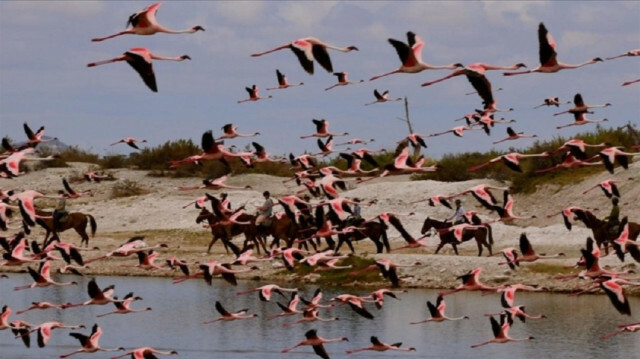
Human activities and changing weather patterns are affecting the world’s largest colony of migratory birds in Tanzania’s northern Arusha region, say environmentalists.
Speaking to Anadolu Agency, George Saning’o, a local environmental activist at Pinyinyi village in Longido district, said the region hosts more than 2.5 million lesser flamingos every year, whose numbers are dwindled over time.
The pink color lesser flamingo birds are classified as near threatened due to declining population and the low number of breeding sites.
He said drought spells and extreme weather have caused erratic water flow into the lake thus affecting the degree of its salinity which is necessary for the growth of algae that provide food to the birds.
“When the water level increases it also creates a problem for flamingos whose survival depends on green algae,” said the environmentalist.
Nestled on the borders of Tanzania and Kenya, Lake Natron due to its warm waters and salt, soda and magnesite deposits is an ideal breeding ground for the Rift Valley flamingos.
The birds, whose nests float in the middle of the lake, demand a perfect balance of water in the lake, to keep themselves safe from predators.
With its surface temperatures often rising to 40 degrees centigrade, the pink and red alkaline waters do not allow wildlife to grow in the vicinity. But the flamingoes have made this hell on earth their paradise.
Every year, the strutting birds are spotted stomping their legs in fascinating romantic dances after which they pair up and nest in the middle of the shallow lake.
Local villagers told Anadolu Agency that they are taking measures to conserve the lake to allow it to host treasures flamingoes.
“One of the measures is to educate pastoral communities about sustainable use of freshwater resources,” said Julius Laipanoi, a resident at Magadini village.
- Greatest tourist attraction
In 2006 an India- based company had proposed to build a facility to extract soda ash or sodium carbonate -- used for making glass, detergents, and dyes. But the project was halted in 2008 after it provoked outrage.
The vast flock of flickering pink birds is one of the greatest tourist attractions highlighting the potential of Tanzania’s tourism industry which contributes 17.2% to the country’s gross domestic product and 25% of all foreign exchange revenues.
Local scientists describe the survival of lesser flamingos in the highly alkaline lake as astonishing.
“It is hard to imagine anything can survive in those salty, alkaline water,” said Flower Msuya, a marine biologist at the University of Dar es Salaam.
She said that these birds have adopted the hostile conditions and have tough skin on their legs to prevent burns from the caustic water.
“High temperature doesn’t bother them, they can submerge their heads in hot water almost boiling,” she told Anadolu agency.
She said this variety of flamingos can drink the salty alkaline water in the caustic soda lakes because of the salt gland in their heads which sprinkle out excess minerals through their nasal cavity.
Jack Godwin, conservation officer at Tanzania Tourism Ministry said the government is committed to protecting endangered species including lesser flamingos.
“We support environmentally friendly tourism activities intending to protect endangered bird species and generate sustainable incomes for the communities,” he said.













